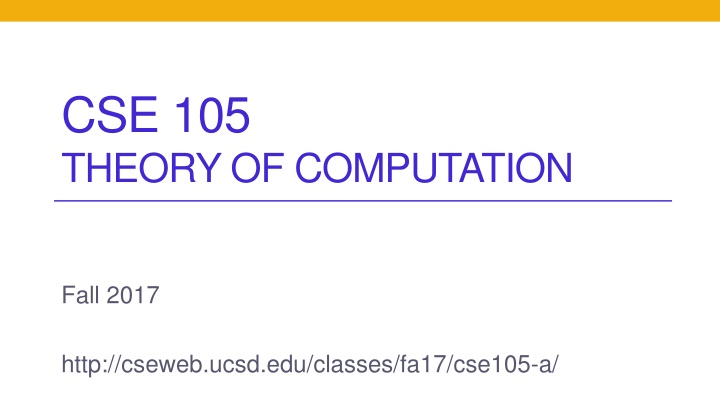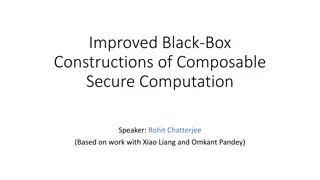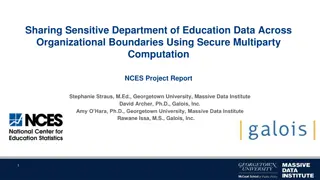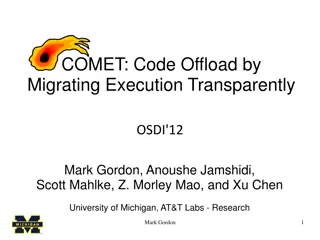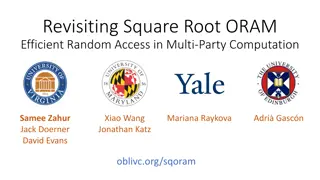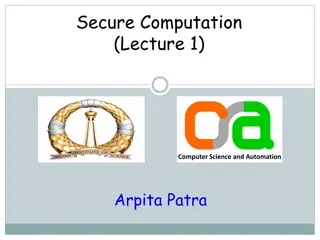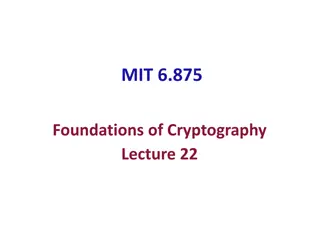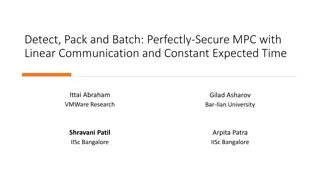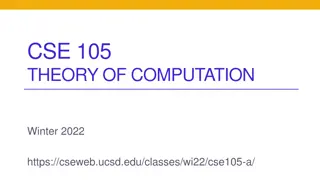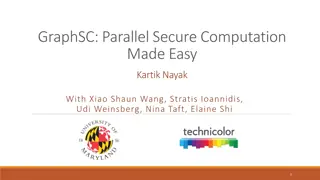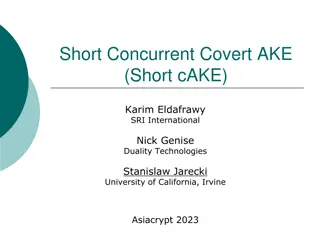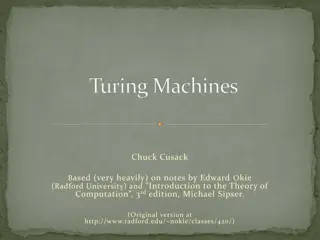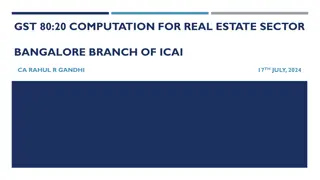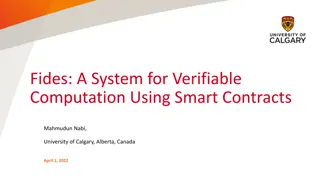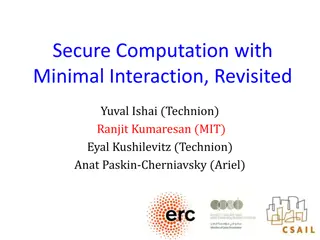Theory of Computation Fall 2017 Course Details and Guidelines
This content provides information about the Theory of Computation course offered in Fall 2017 at UCSD. It covers learning goals, introductions, the use of clickers, logistics including homework, exams, and office hours, tips on how to excel in the course with integrity, and guidelines on academic integrity. Students are encouraged to prepare ahead of class, engage actively, work on homework in groups, and seek help when needed.
Download Presentation

Please find below an Image/Link to download the presentation.
The content on the website is provided AS IS for your information and personal use only. It may not be sold, licensed, or shared on other websites without obtaining consent from the author.If you encounter any issues during the download, it is possible that the publisher has removed the file from their server.
You are allowed to download the files provided on this website for personal or commercial use, subject to the condition that they are used lawfully. All files are the property of their respective owners.
The content on the website is provided AS IS for your information and personal use only. It may not be sold, licensed, or shared on other websites without obtaining consent from the author.
E N D
Presentation Transcript
CSE 105 THEORY OF COMPUTATION Fall 2017 http://cseweb.ucsd.edu/classes/fa17/cse105-a/
Clickers PETER 108: AC To change your remote frequency 1. Press and hold power button until flashing 2. Enter two-letter code 3. Checkmark / green light indicates success When did you take CSE 20? Why use clickers? A. Winter 2017 B. Fall 2016 C. Spring 2016 D. Winter 2016
Logistics Homework: ~1 / week; 7 over the quarter (drop lowest score) can work in groups! In-class: Group discussion + iClicker ; Read book first Discussion section: more examples, homework warmup Weekly review quiz: 5 Qs each Friday; can make up missed points through participation Exams: Midterm 1, Monday October 30, in class Midterm 2, Monday November 27, in class Final Exam ThursdayDecember 14, 7-10pm Gradescope: Homework submission, exam return Piazza: announcements and Q&A. One-on-one office hours: with me and your TAs.
How to excel Prepare ahead of class Read assigned sections, read homework questions Engage in class Discuss questions with your neighbors, look for (counter)examples Go over wrong choices too! Reinforce after class Briefly summarize what you learned Start homework early and work in a group Tackle problems together: brainstorm, plan, and solve together Seek help and seek to help others, with integrity
How to excel with integrity It's an integrity violation to Click in for someone who is absent Sign discussion attendance sheet for someone who is absent Ask others to give you specific HW or review quiz or test answers Share your answers on HW or review quiz or test Work on HW with anyone other than your HW partners Search the internet or other resources not provided for the class for HW solutions Share answers or notes while taking an exam This not a complete list you are responsible for knowing and following the guidelines Academic integrity violations will be taken seriously and reported immediately
About this class: Academic integrity You are working on a homework question with your group members and are stuck on a question. You run into a friend who solved the problem already and shows you her solution. You look at it, but put it away before continuing the group conversation. Is this acceptable? PETER 108: AC Yes No A. To change your remote frequency 1. Press and hold power button until flashing 2. Enter two-letter code 3. Checkmark / green light indicates success B.
About this class: Academic integrity You're not sure if you are interpreting a homework problem correctly. You write a post on Piazza explaining your approach to answering it, and asking if this is the correct way to interpret the question. Is this acceptable? Yes No A. B.
I dont know if you already noticed But I have a strong accent Nothing I can do about it, but it might make it harder for you to understand me (in particular as the topics we learn will be new to you) In fact, educational research shows that students who have a professor with a strong accent actually learn better (maybe because they need to focus more) Some solutions: Everything I say is recorded: https://podcast.ucsd.edu/ Slides will be available in the class website If you don t understand something, don t wait come to office hours. Sometimes one small clarification can make all the difference.
CSE 105's big questions What problems are computers capable of solving? What resources are needed to solve a problem? Are some problems harder than others? Making a decision or computing a value based on some input
Questions about algorithms Are they correct (for given specification)? Is there a better approach to solving the same problem? Does each problem have a solution? If so, can that solution be found by an algorithm?
Questions about algorithms Are they correct (for given specification)? CSE 20, 21, 101 Is there a better approach to solving the same problem? CSE 100, 101, CSE 105: complexity theory Does each problem have a solution? CSE 105: computability theory If so, can that solution be found by an algorithm? CSE 105: computability theory
Group activity Goal: find treasure hidden somewhere in grid. Describe an algorithm for each robot. Do you need to assume anything? Do you need to keep track of any information? Robot 1: can move North, East, West, South. Robot 2: can move in four diagonal directions.
Computer = algorithm? Your experience: Java, python, C, etc. Other computer models: Quantum computers DNA computation Supercomputers / Datacenters with parallelized and distributed computation Power-sensitive computation for mobile Embedded circuits Different contexts call for different algorithms + different performance constraints
Bird's eye view of CSE 105 Pick a model of computation Study what problems it can solve Prove its limits
Bird's eye view Classification: is input of type A or not? e.g. is n prime? is list sorted? Pick a model of computation Study what problems it can solve Computation: for specific input, what value should I output? e.g. what's min cost of Hamiltonian tour? Prove its limits
Bird's eye view Classification: is input of type A or not? Decision problem Pick a model of computation Study what problems it can solve Computation: for specific input, what value should I output? Function problem Prove its limits
Bird's eye view Classification: is input of type A or not? Decision problem Pick a model of computation Study what problems it can solve Computation: for specific input, what value should I output? Function problem Prove its limits
Bird's eye view Classification: is input of type A or not? Decision problem Pick a model of computation Study what problems it can solve { w | w is of type A} PRIME = { 2, 3, 5, 7, } SORTED = { <1,3>, <-1, 8, 17> } Prove its limits Decision problems are coded by sets of strings
Models of computation Finite automata Context-free grammars Turing machines
Models of computation Finite automata Context-free grammars Turing machines
So let's get going Textbook reference: Chapter 0, Section 1.1 Discussion section (find yours!) Friday: Review quiz 1 due; see link on website Monday: HW1 due 11pm via Gradescope.
Code input as strings Model memory using states Automata Text processing grep, regexp Natural language processing Hardware design Moore machines, Mealy machines: CSE 140 Controllers / Robots SPIS!
Example: subway turnstile A subway turnstile is locked until a token is entered, at which point it unlocks in response to a single push, after which it locks again. When you approach the turnstile, will it open? How can we model this problem as a classification question?
Example: subway turnstile A subway turnstile is locked until a token is entered, at which point it unlocks in response to a single push, after which it locks again. When you approach the turnstile, will it open? How can we model this problem? Alphabet: {token entered, push} Input: sequence of moves Language: {sequences of moves giving unlocked gate}
Example: subway turnstile A subway turnstile is locked until a token is entered, at which point it unlocks in response to a single push, after which it locks again. t Locked Unlocked p
Example: subway turnstile What happens if the turnstile is pushed while locked? A subway turnstile is locked until a token is entered, at which point it unlocks in response to a single push, after which it locks again. A. Transition to unlocked B. Stay locked C. Send error message D. None of the above t Locked Unlocked p
Example: subway turnstile A subway turnstile is locked until a token is entered, at which point it unlocks in response to a single push, after which it locks again. t p t Locked Unlocked p
Example: subway turnstile What's the initial state of the turnstile? A subway turnstile is locked until a token is entered, at which point it unlocks in response to a single push, after which it locks again. A. Locked B. Unlocked t p t Locked Unlocked p
Example: subway turnstile A subway turnstile is locked until a token is entered, at which point it unlocks in response to a single push, after which it locks again. t p t Locked Unlocked p
Finite automata and decision problems Decision problem "is w of type A?" coded by the set { w | w is of type A} Those inputs for which the answer is "yes" A problem is solved by a finite automaton if the machine accepts all w for which the answer is yes and rejects all w for which the answer is no
Example: subway turnstile Problem: Which sequences of moves will unlock turnstile? Alphabet: {t, p} Language: {sequences of moves giving unlocked gate} = { t, ppt, } = {strings over alphabet that, when input to this automaton, end in Unlocked state} p t t Locked Unlocked p
Vocabulary review From CSE20, etc. Sipser p. 14 { a,b,c,d,e } { a,b }* Includes empty string Includes a, aa, aaa Includes b, bb, bbb Includes ab, ababab, aaaaaaabbb Does not include infinite sequences of a's and b's Has infinitely many different elements | ababab | = 6 The length of the string ababab is 6 | { a,b,c,d,e } | = 5 The size of the set {a,b,c,d,e} is 5 A language (over alphabet ) is a set of strings (over ) The set whose elements are a,b,c,d,e The set of finite strings over a,b
Deterministic Finite automaton Sipser p. 34, 40 Input: finite string over a fixed alphabet Output: "accept" or "reject" Accept state (double circle) Start state (triangle/arrow) The language recognized by the machine is the set of strings it accepts.
Deterministic Finite automaton Sipser p. 34, 40 Computation of the machine on an input string Sequence of states in the machine, starting with the initial state, determined by transitions of the machine as it reads additional input symbols. How does the computation of the machine on a string related to whether the string is accepted by the machine? A. If the first state in the computation is an accept state, the string is accepted. B. If any state in the computation is an accept state, the string is accepted. C. If the last state in the computation is an accept state, the string is accepted. D. If all of the states in the computation are accept states, the string is accepted. E. None of the above
Finite automaton Input: finite string over a fixed alphabet Output: "accept" or "reject" Accept state (double circle) Start state (triangle/arrow) Example input: 0001
Finite automaton Input: finite string over a fixed alphabet Output: "accept" or "reject" What is the computation of this machine on input 110? A. q1, q1, q0 C. q0, q1, q2, q3 E. None of the above B. q1, q1, q2 D. q0, q1, q1, q2
Finite automaton Input: finite string over a fixed alphabet Output: "accept" or "reject" Is the empty string accepted? Is the string 001 accepted? Is the string 0011010101010 accepted? What is the language recognized by this machine?
For next time Start Homework 1 due Monday Set up course tools: Gradescope, Piazza Find group members Read all the questions + relevant examples in the book Start working Review CSE 20 / Math 109 / CSE 21 / Sipser Ch 0 as needed.
